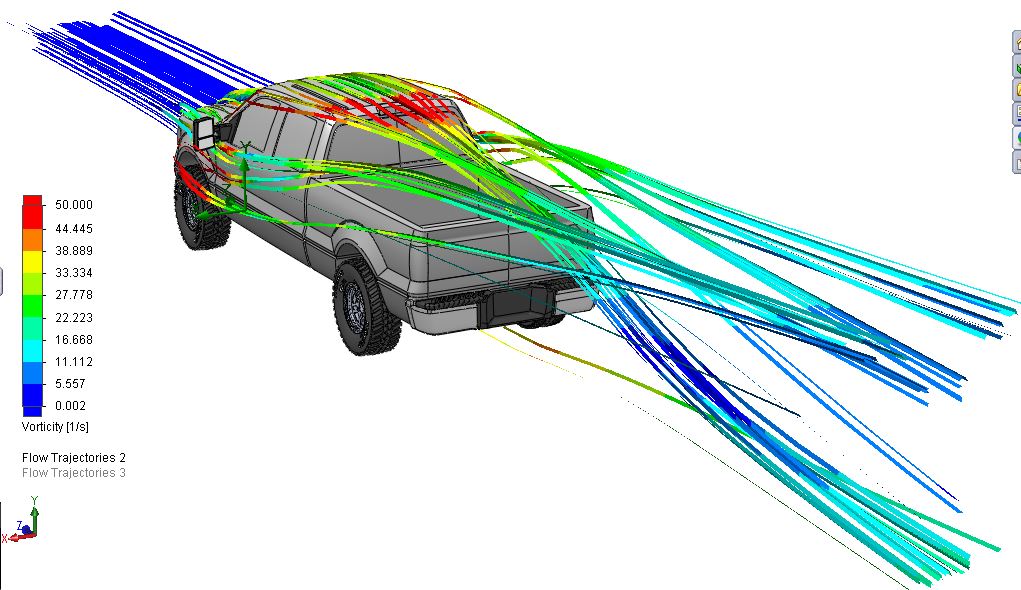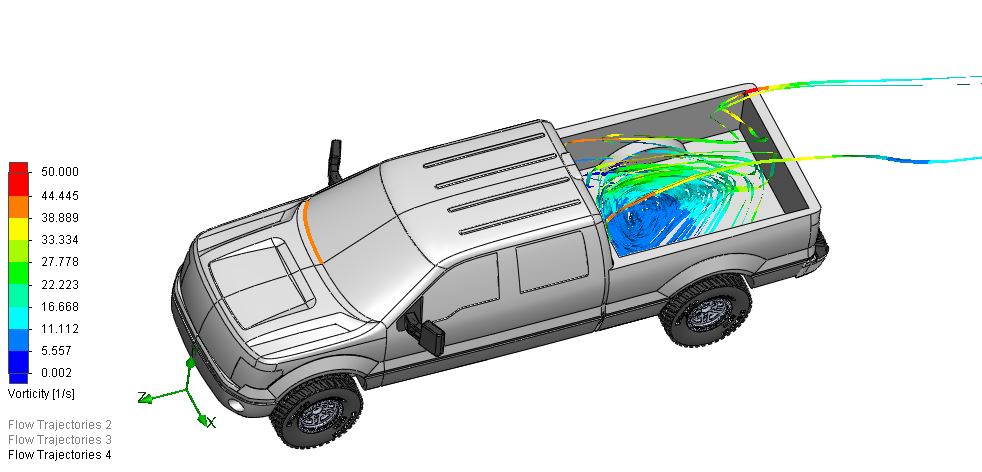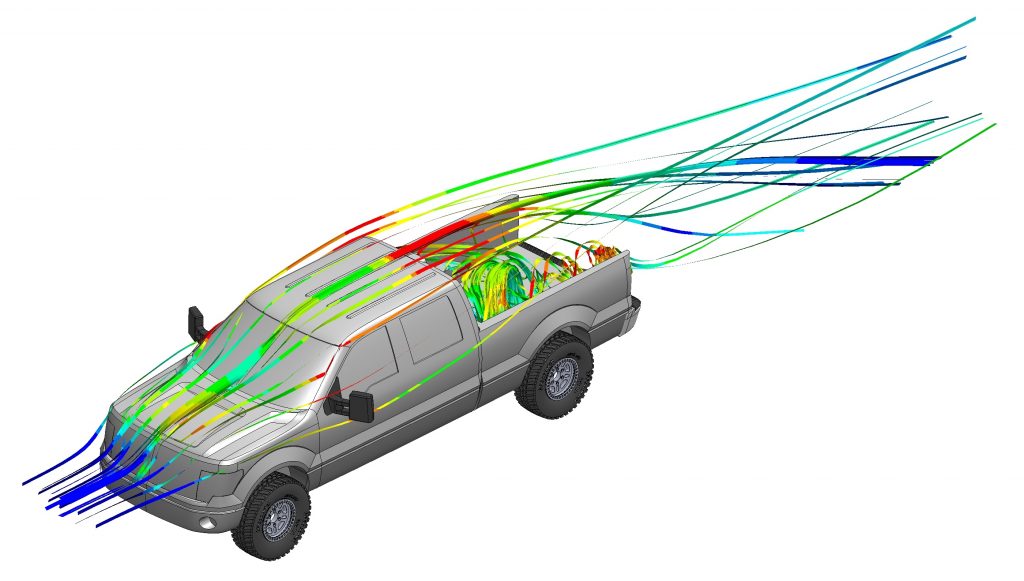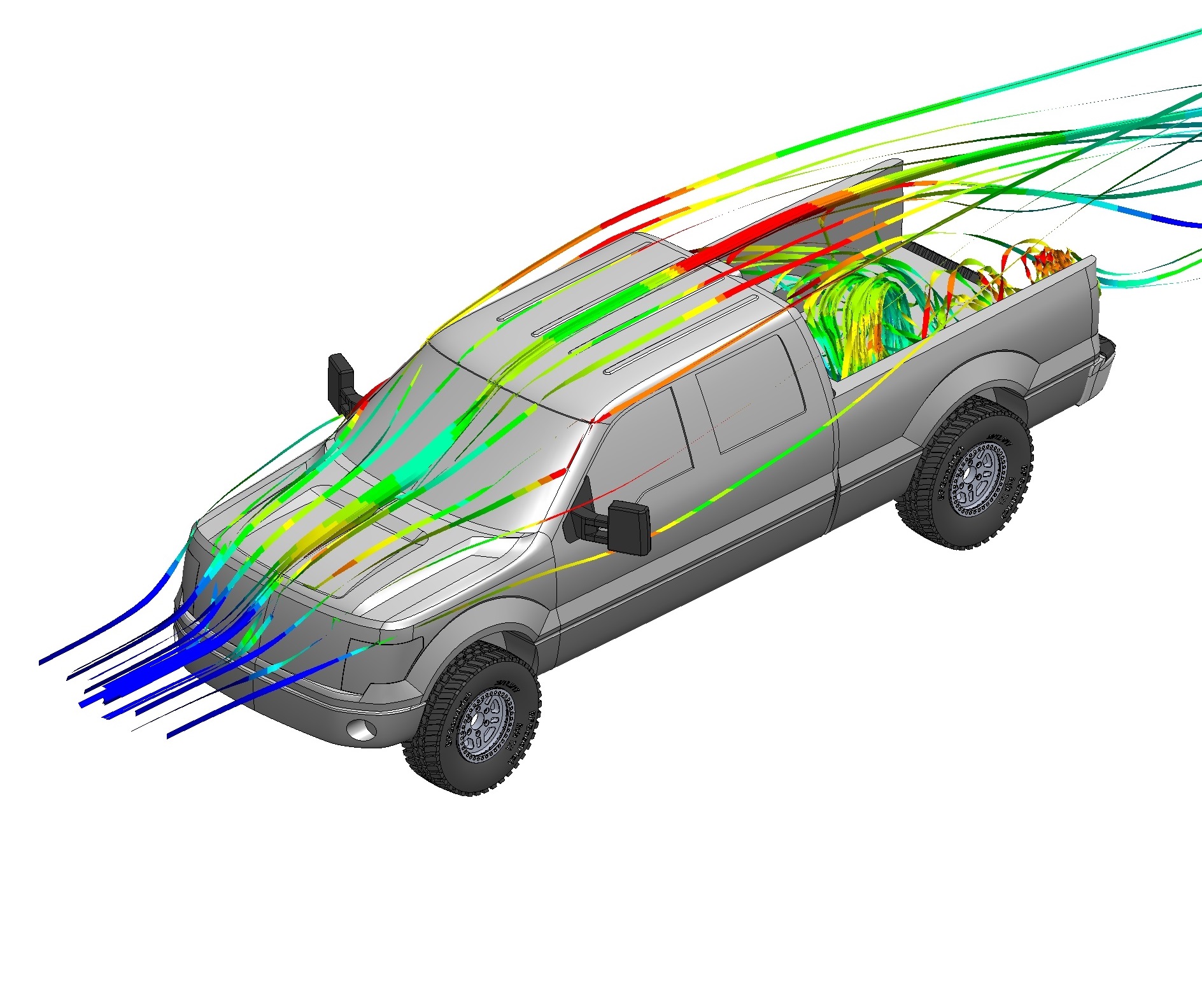Our first tow rig was a 2000 F350 7.3 Powerstroke Dually, amazing truck, however the tailgate had been stolen before we bought it, so we started to look for affordable replacements. One of the first things that comes up, is the recurring theme of “flow through” steel grate style tailgates that claim to be more fuel efficient because they let air through instead of trapping it.
…But is it really?
No. in fact, the aero analysis shows that the drag force is 19% higher at highway speeds with the tailgate removed. This is directly proportional to your fuel economy, which means that if our F150 normally gets 18.5mpg, we would get 15.5mpg on the highway if our tailgate was down. Ouch.

What you can see in the image above is a velocity plot down the centerline of the vehicle with the tailgate removed. Now compare it to the image below which shows the same plot, with the tailgate on. without getting too technical, notice the difference of the shapes of the blue region, where the air velocity is virtually zero with respect to the truck.

Now, at initial glance, you may say that the plot with the tailgate up has the zero zero velocity air extending out further, and thus it has more of a low pressure zone behind the truck. But that is not what is actually happening.

Although it is far from perfect, the airflow over a pickup truck bed with a closed tailgate is actually rather smooth. This is because the inside the bed with the tailgate closed is almost “trapped” and is just circulating inside the bed behind the cab glass, and it doesn’t really escape or go anywhere (as shown in the image below). What this does is it allows the air to flow from the roof, over this circulating air and past the top of the tailgate.

Now compared the the flow with the tailgate down, the air goes from the roofline down to roughly 1/2 of the bed length, and then gets sucked into the low pressure zone behind the cab. What this does is basically applies a low pressure drag force over then entire aft cab surface. While the closed tailgate configuration works out to have the primary low pressure zone just behind the tailgate. (There are other aspects at play here also like the air separation point)

Another way to think of it, is the circulating air within the bed of the closed tailgate configuration, draws an imaginary line from the roof to the top of the tailgate and makes the truck have more of a smooth wing/airfoil shape, where as the open tailgate has a large flat surface much like a brick; the airfoil obviously having a lower drag coefficient than a brick.
Maybe one of these day’s I’ll empty out the bed, and drive around all week with the tailgate down to correlate some test data.


February 26, 2020 at 5:26 pm
what about if you place a Xterra thing on top of the cabin ?
May 29, 2020 at 7:39 pm
Hi, Carlos! Can you be more specific! We’d love to help. Thanks!
April 18, 2021 at 4:44 am
Do you happen to be referring to the luggage rack on top of a Nissan Exterra?
April 30, 2021 at 9:48 pm
I’m not quite sure where the Xterra roof rack can apply here, did you mean to post the comment on one of the other articles? If not please explain and I’ll do my best to answer. Thanks!
May 13, 2020 at 10:34 pm
Question? I’ll be towing a 12’ trailer with two ATV,s 3800 miles. What is the best way to configure the front of the trailer to off set the air stream coming off the closed tailgate?
May 29, 2020 at 7:58 pm
Hi Jerry, Thanks for your question! This would take some extra analysis — but sure would be an interesting case study! Maybe adding some wind deflectors to the truck might help air pass over the trailer… but, you still have to deal with the drag of the flat back on the trailer.
April 16, 2021 at 12:57 am
If you add a fifth wheel trailer to the mix, wouldn’t no tailgate be a better option? In my opinion, a tailgate with a firth wheel would pack air in the bed where no tailgate would allow air to spill out under the fifth wheel.
April 30, 2021 at 9:45 pm
If you add a goosneck or a 5th wheel, I think you mess up the flow back there regardless so tailgate may not make any difference. The reason it works here is because the tailgate up creates a bubble that the air flows over, and catches the tailgate lip, so if that air hits the 5th wheel structure, the entire concept is null.
November 26, 2022 at 1:22 pm
Great info. Thanks. I was looking into this. Would a hard top over the bed plus an airfoil at the tailgate improve (lessen) drag further?
January 5, 2023 at 8:37 am
A Tonneau cover would help things. A spoiler or wing, by definition would create drag.